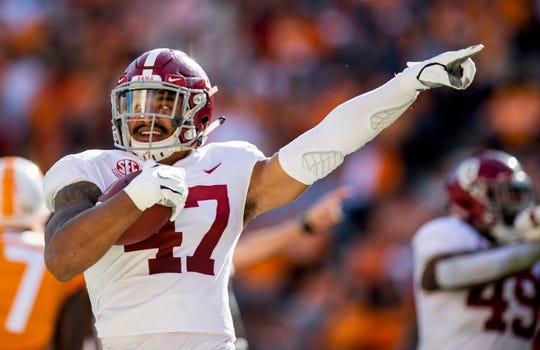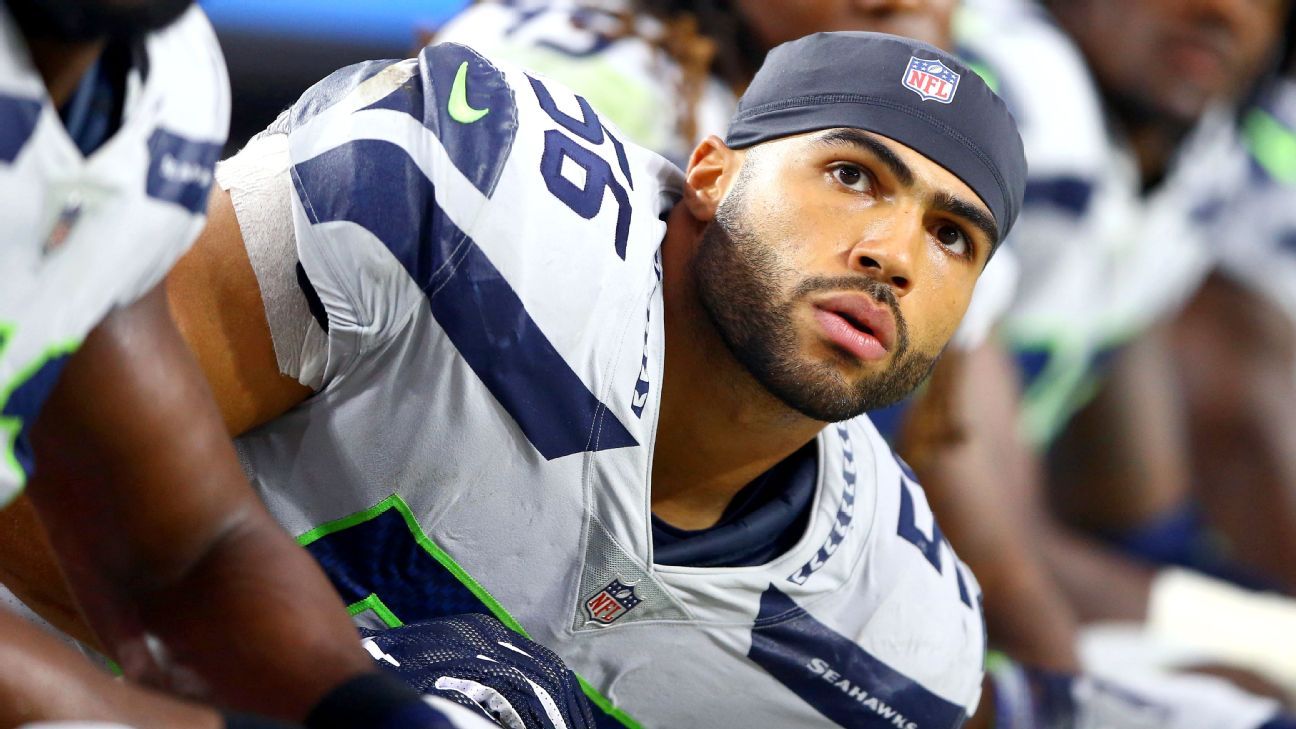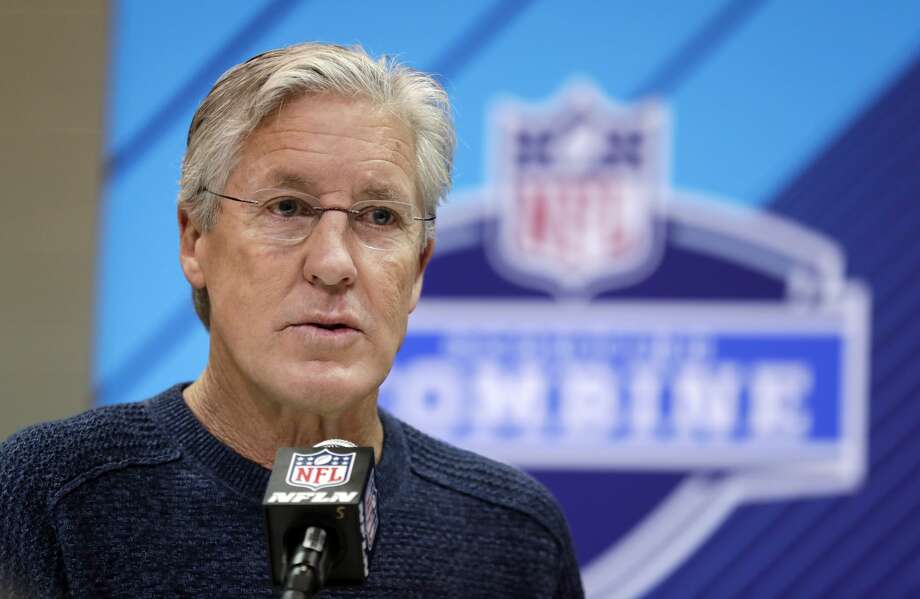
Christian Miller has almost identical measurables to K.J. Wright
Seahawks showing interest in Drew Lewis?
According to Tony Pauline they were one of three teams spending time with Lewis at the Colorado pro-day. It’s not a big surprise. They have a massive need at linebacker and also a ‘type’ at the position. Lewis fits the bill with a 4.49 forty, 34 inch vertical, 10-9 broad and a 7.02 three cone. Reportedly he can also squat 515lbs.
Interestingly his father is a former Seahawks cornerback and actually spent 12 years in Seattle’s front office. His cousin is ESPN analyst Louis Riddick. Drew Lewis is a player to watch over the coming weeks.
Add another running back to the watch-list
Nebraska’s Devine Ozigbo measured at 5-11 and 222lbs at his pro-day. He ran a 4.54 forty, jumped a 37 inch vertical and a 10-4 broad. That’s the kind of size and explosive power Seattle looks for in a running back.
Meanwhile offensive lineman Tanner Farmer, a former four-star recruit and 96.84 SPARQ tester in High School, had a 32.5 inch vertical, a 9-10 broad jump and put up 39 reps on the bench press. Those marks warrant an outstanding 3.80 in TEF.
Post-combine mock draft
A few quick thoughts before getting into this…
1. Don’t assume D.K. Metcalf is suddenly a top-10 pick
Running a 4.33 at 228lbs is impressive. Some teams might be wowed by Metcalf’s potential and clear athleticism. However, here’s the reality of his combine performance. We learnt, unsurprisingly, he can run fast in a straight line. We already knew that. We’ve all seen the first snap of the Ole Miss vs Alabama game from 2018. He’s a superb downfield runner at his size. Yet his 4.50 short shuttle is the kind of time you’d expect from a decent defensive tackle. Trysten Hill, who we featured yesterday, ran a 4.38 short shuttle at 308lbs. Metcalf also ran a 7.38 three cone.
Teams were supposedly concerned about his size going into the combine. Surely those fears were confirmed here? Those times suggest a level of stiffness and an inability to change direction quickly. Then you add in the neck injury which for a time was considered career-threatening plus the all-too-frequent concentration drops. Could he be a top-15 pick after running a 4.33? Sure. Is it just as likely he lasts because of the concerns noted here? Yes, definitely.
2. Why is Jonah Williams frequently mocked in the top-10?
It’s been that way for a full draft season. Even Mike Solari seemed enamoured with him, calling on Williams to show the rest of the O-liners at the combine how to do the on-field drills. Yet his testing numbers show a player who lacks explosive traits (28 inch vertical, 8-4 broad jump) and didn’t test well in terms of agility (8.01 three cone, 4.79 short shuttle). He’s 6-4 and 302lbs.
Bob McGinn posted an article this week citing scouting sources on Williams. The positives included consistency and good hand placement. One scout called him a “good not great” player. Another said, “You’re watching him play left tackle, which he’s not. The more you watch him, the more you kind of sober up and ignore the chatter. You start thinking about him as a right tackle or a guard. You’re kind of reaching if you think that guy will be a top-10 left tackle.” A final scout added, “He’s a catcher. As a run blocker, he has absolutely no strength. Stalemates are his best.”
3. I’m torn on how to react to the combine
Montez Sweat’s excellent forty yard dash flashed elite-level speed and that could be enough to promote him into top-10 contention. He also had a strange exit from Michigan State and didn’t look comfortable in space during drills. Still — there aren’t many 260lbs players running a 4.41 with 36 inch arms so I’m putting him at #7.
Brian Burns on the other hand I’m only moving into the late first. He too had a great combine and answered some questions by weighing 249lbs. However, teams will likely look into the legitimacy of that weight. Did he drink a lot of water before being weighed? Because there’s no way he put on 20lbs of muscle since the end of the college season having reportedly played in the 220’s. He’s a talented player and a great speed rusher. But that doesn’t automatically mean teams will draft an undersized EDGE in the top-20. Doubts about his playing size and ability to defend the run will remain.
The mock in full
#1 Arizona — Kyler Murray (QB, Oklahoma)
#2 San Francisco — Nick Bosa (DE, Ohio State)
#3 New York Jets — Quinnen Williams (DT, Alabama)
#4 Oakland — Josh Allen (EDGE, Kentucky)
#5 Denver (via TB) – Drew Lock (QB, Missouri)
#6 New York Giants — Rashan Gary (DE, Michigan)
#7 Jacksonville — Montez Sweat (EDGE, Mississippi State)
#8 Detroit — T.J. Hockenson (TE, Iowa)
#9 Buffalo — Jawaan Taylor (T, Florida)
#10 Tampa Bay (via DEN) – Devin White (LB, LSU)
#11 Cincinnati – Dwayne Haskins (QB, Ohio State)
#12 Green Bay — Clelin Ferrell (DE, Clemson)
#13 Miami — Dexter Lawrence (DT, Clemson)
#14 Atlanta — Devin Bush (LB, Michigan)
#15 Washington — Greedy Williams (CB, LSU)
#16 Carolina — Andre Dillard (T, Washington State)
#17 Cleveland — Ed Oliver (DT, Houston)
#18 Minnesota — Christian Wilkins (DT, Clemson)
#19 Tennessee — Noah Fant (TE, Iowa)
#20 Pittsburgh — Marquise Brown (WR, Oklahoma)
#21 Buffalo – (via SEA) – Parris Campbell (WR, Ohio State)
#22 Baltimore — Jonah Williams (C/G, Alabama)
#23 Houston — Cody Ford (T, Oklahoma)
#24 Oakland — Irv Smith Jr (TE, Alabama)
#25 Philadelphia — Josh Jacobs (RB, Alabama)
#26 Indianapolis — D.K. Metcalf (WR, Ole Miss)
#27 Pittsburgh (via OAK) — Byron Murphy (CB, Washington)
#28 LA Chargers — Kaleb McGary (T, Washington)
#29 Kansas City — Brian Burns (EDGE, Florida State)
#30 Green Bay – Jachai Polite (EDGE, Florida)
#31 LA Rams — Garrett Bradbury (C, NC State)
#32 New York Giants (via NE) — Daniel Jones (QB, Duke)
The trades explained
Denver (#10) trades with Tampa Bay (#5) to select Drew Lock
I suspect some teams will grade Drew Lock as the #1 or #2 quarterback in this draft. Several reports have suggested John Elway is enamoured with Lock. The trade for Joe Flacco could be an attempt to recreate Kansas City’s plan (veteran — Alex Smith, rookie — Patrick Mahomes). If so, are they going to risk the Giants taking their guy at #6? They give the Buccs their 2020 first rounder.
Buffalo (#40) trades with Seattle (#21) to select Parris Campbell
The Bills need to surround Josh Allen with weapons. I have them taking Jawaan Taylor with their first pick. Will they move up to secure some genuine downfield speed? They could target Marquise Brown or Parris Campbell (who ran a 4.31 at the combine). The Bills have an extra fourth and fifth round pick so they have something to spend to move up. They give Seattle a third, fourth and fifth to trade up 19 spots.
Oakland (#27) trades with Pittsburgh for Antonio Brown
This one increasingly seems inevitable. It’s simply a case of whether the Raiders need to give up one of their first rounders. Can they get the Steelers to accept a second round pick? Brown to the Raiders could be completed before the end of the week.
The New York Giants (#37) trade with New England (#32) to select Daniel Jones
I can see a scenario where the Giants don’t take a quarterback with their first pick but trade back into the late first to select one. That could be Daniel Jones. There’s a connection between the Manning’s and Jones through Duke coach David Cutcliffe. This could be a plausible way to make a seamless transition from the older quarterback to a younger player. The Pats take a fourth rounder to move down five spots.
Second round
#33 Arizona — Greg Little (T, Ole Miss)
#34 Indianapolis — Dre’Mont Jones (DT, Ohio State)
#35 Oakland — Jeffery Simmons (DT, Mississippi State)
#36 San Francisco — Taylor Rapp (S, Washington)
#37 New England (via NYG) — Josh Oliver (TE, San Jose State)
#38 Jacksonville — Johnathan Abram (S, Mississippi State)
#39 Tampa Bay — Will Grier (QB, West Virginia)
#40 Seattle (via Buf) — Christian Miller (EDGE, Alabama)
#41 Denver — Dawson Knox (TE, Ole Miss)
#42 Cincinnati — Mack Wilson (LB, Alabama)
#43 Detroit — Justin Layne (CB, Michigan State)
#44 Green Bay — Deebo Samuel (WR, Green Bay)
#45 Atlanta — Chris Lindstrom (G, Boston College)
#46 Washington — N’Keal Harry (WR, Arizona State)
#47 Carolina — Darnell Savage (S, Maryland)
#48 Miami — Dalton Risner (T, Kansas State)
#49 Cleveland — Hakeem Butler (WR, Iowa State)
#50 Minnesota — Erik McCoy (C, Texas A&M)
#51 Tennessee — Chase Winovich (EDGE, Michigan)
#52 Pittsburgh — Zach Allen (DE, Boston College)
#53 Philadelphia — A.J. Brown (WR, Ole Miss)
#54 Houston — Deandre Baker (CB, Georgia)
#55 Houston — Chauncey Gardner-Johnson (S, Florida)
#56 New England — L.J. Collier (DE, TCU)
#57 Philadelphia — Trayvon Mullen (CB, Clemson)
#58 Dallas — Jaylon Ferguson (EDGE, Louisiana Tech)
#59 Indianapolis — Isaiah Johnson (CB, Houston)
#60 LA Chargers — Elgton Jenkins (C, Mississippi State)
#61 Kansas City — Jerry Tillery (DT, Notre Dame)
#62 New Orleans — Miles Boykin (WR, Notre Dame)
#63 Kansas City — Terry McLaurin (WR, Ohio State)
#64 New England — Juan Thornhill (S, Virginia)
Seahawks seven-rounder
This includes the trade with Buffalo presented in the mock above.
#40 (R2) — Christian Miller (LB, Alabama)
#74 (R3) — Trysten Hill (DT, UCF)
#84 (R3) — Marvell Tell (S, USC)
#124 (R4) — Dru Samia (G, Oklahoma)
#131 (R4) — Gary Jennings (WR, West Virginia)
#158 (R5) — Trevon Wesco (TE, West Virginia)
#159 (R5) — Derrek Thomas (CB, Baylor)
Thoughts on each pick
#40 Christian Miller (LB, Alabama)
This could go one of two ways. Either he plays EDGE and acts as a pass rusher. Or how about this. Miller is 6-3, 247lbs and has 35 1/8 inch arms. K.J. Wright at his combine was 6-3, 246lbs with 34 7/8 inch arms. Now — they are different players. But body wise they are similar. We know the Seahawks are willing to try and coach an EDGE to become a linebacker (see: Bruce Irvin). So this could be an option. The Seahawks also seemingly pay attention to the short shuttle at linebacker. Miller didn’t run a short shuttle at the combine but at SPARQ he was timed at 4.18. In comparison, Devin White ran a 4.17.
#74 Trysten Hill (DT, UCF)
I wrote about Hill’s tape yesterday but here’s why I think he might fit for the Seahawks. They’ve consistently drafted defensive linemen who test well in the short shuttle. Hill ran an excellent 4.38. Pete Carroll hasn’t drafted a defensive linemen with sub-33 inch arms. Hill has 33.5 inch arms. He’s also extremely explosive (35 inch vertical) and quick (third fastest 10-yard split among DT’s). In terms of testing, he’s as explosive as Ed Oliver. This would be an opportunity to get one of the best defensive tackles in a deep class. He’ll only last this long due to questions about his final year at UCF, where he seemingly didn’t see eye-to-eye with the new coaches upon Scott Frosts departure. The Seahawks love an opportunity like this.
#84 Marvell Tell (S, USC)
Seattle’s defense utilised three safety’s at times in 2018. Will they take it a step further this year? Justin Coleman is a free agent. With so many of the safety’s running 4.4 or above at the combine — their next nickel could be a safety. Marvell Tell has the quickness and agility to potentially switch to corner. He ran an incredible 6.63 three cone and a 4.01 short shuttle. It also helps that he’s 6-2 and has 33 1/8 inch arms — so they might even try him outside. He also jumped a 42 inch vertical and was a captain at USC. He’s a terrific talent who could be tried at multiple positions.
#124 Dru Samia (G, Oklahoma)
Why Samia? Simple. He’s a BAMF who excels in the running game. He’s the most aggressive, nasty offensive linemen in the draft. He wants to fight everyone and get after you. The Seahawks regained their identity in 2018 and Samia fits into that. He’s not going to excel in pass-pro. He’s a pure run blocker. That’s what the Seahawks seem to go for.
#131 Gary Jennings (WR, West Virginia)
All but two of Seattle’s 2010-18 draft picks at receiver have run in the 4.4’s. The two that didn’t were seventh round flier Kenny Lawler and Chris Harper (who ran a 4.50). So the chances are any wide out they draft will run in the 4.4’s. I picked Jennings because he ran a 4.42, excels at making chunk plays, competes for the ball, finishes runs, is clever to shield defenders and gain position and he’s effective working inside or out. He’d be a nice compliment to what they already have.
#158 Trevon Wesco (TE, West Virginia)
Wesco is 6-3, 267lbs and has nearly 35 inch arms. He’s basically another offensive linemen — which as we’ve come to learn over the last 12 months, is the type they’re going for. He also has good special teams value, plays with an aggressive attitude, appears to enjoy blocking in the running game and is basically right out of the Will Dissly book of tight ends. He’s no slouch — he ran a 4.38 short shuttle which was faster than Josh Oliver (4.47) and not far behind Irv Smith Jr (4.33). Wesco could also be used as a full back. Seattle has regularly targeted tight ends with a sub-7.10 three cone but only three players managed that at the combine (Noah Fant, T.J. Hockenson, Kaden Smith).
#159 Derrek Thomas (CB, Baylor)
When he ran the forty at the combine he looked like a Seahawks cornerback. Long and lean. He’s 6-3, 189lbs and has 34 inch arms. Sound familiar? Tre Flowers is 6-3, 202lbs and has 34 inch arms. There are more rounded cornerbacks Seattle could target such as Jamal Peters or Lonnie Johnson. However, it’s possible both players will be gone by this point — leaving Seattle to take a profile fit.
Other players I seriously considered for this mock:
Will Grier (QB, West Virginia)
The best deep-ball thrower in college football for two years and possibly the best option if Seattle wants to insure against a Russell Wilson-contract saga.
Alec Ingold (FB, Wisconsin)
A tenacious full back — something Seattle’s offense has been lacking for a while. He’ll also contribute on special teams.
Several tight ends, including Drew Sample (TE, Washington)
We could see a long list of tight ends drafted in the first three rounds. The Seahawks could easily go in that direction early.
Several of the 4.4 runners at receivers
They could take a receiver at any point in this draft, including with their first pick. There aren’t any clear top-10 wide outs but there’s plenty of depth.
Bobby Evans (T, Oklahoma)
He’s physical, tough and enjoys the run game. He’s versatile enough to play guard or tackle and they might need some insurance for the long term.
Isaiah Prince (T, Ohio State)
He stood out at the combine as the most athletic and impressive looking offensive tackle. He’s 6-6, 305lbs and has +35 inch arms.
Michael Jordan (G/C, Ohio State)
He has major potential and looked the part at the combine. He could be developed to play any position at the next level.
Justin Hollins (EDGE, Oregon)
A highly athletic EDGE with the kind of quickness, speed and length they’ve looked for at the position.
Daniel Wise (DT, Kansas)
A possible specialist interior rusher with the production, length (33 inch arms) and quickness (4.37 short shuttle) they like.
Drew Lewis (LB, Colorado)
Explosive (10-9 broad, 32.5 inch vertical) and quick (4.49) — the type they’ve drafted in the past at linebacker.
Khalil Hodge (LB, Buffalo)
A tackling machine and somebody Tony Pauline reported Seattle has interest in. Gritty player with a backstory.
Lonnie Johnson (CB, Kentucky)
The latest recipient of a stare-out challenge at the combine. Johnson has everything they like — length, speed and toughness.
Jamal Peters (CB, Mississippi State)
A converted safety who lacks speed (4.64) but has a bit of Brandon Browner to his size and tackling.
Marquise Blair (S, Utah)
A heat-seeking missile as a tackler who actually ran better than expected at the combine (4.48).
Juan Thornhill (S, Virginia)
If they’re looking for playmaking in the secondary, Thornhill had six interceptions last season. He also ran a 4.42 forty and jumped a 44 inch vertical and an 11-9 broad. A special athlete.
There are many others I could’ve included, these were just some under consideration in this particular pre-free agency projection.
You can now support Seahawks Draft Blog via Patreon by clicking the tab below.
Become a Patron!






